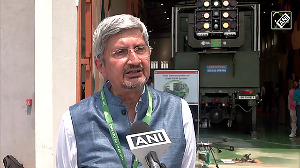Did you see anything different about the Indian cricket team's uniforms? If you were too busy groaning over the lacklustre performance to notice, let us point it out: there's a little swoosh on the arm and below the right collar. It's small, but it's significant.
For the first time, Nike's logo is appearing in connection with an "Indian" sport: cricket. A few months ago, Nike wrested the rights to become the official kit sponsor for the Indian cricket team for the next five years, beating arch-rivals Reebok and Adidas; it paid Rs 196 crore (Rs 1.96 billion) to the Board of Control for Cricket in India for the privilege.
The first "Just Do It" cricket ad also made its appearance during the Champions Trophy last month. "We want to look at what drives the passion for cricket in India. We aim to connect emotionally with our customers," declares Sanjay Gangopadhyay, marketing director, Nike India.
The swoosh has finally swung, and how. The American sports footwear and apparel giant has had a presence in India for close to a decade, but it's consciously held on to its "international" image.
Where Sachin Tendulkar and Dhanraj Pillai were endorsing rivals' products, Nike's ads stuck to Maria Sharapova and Ronaldinho. India didn't really figure in the company's marketing and promotion activities.
That's changed now. And it's likely to change the rules of the game of the Rs 1,100-crore (Rs 11 billion) Indian sports footwear and apparel market.
All these years, market leadership has eluded Nike in India. This is the only market where Reebok is No. 1 (40 per cent marketshare), followed by Adidas (20 per cent). Nike's 15 per cent share is a distant third (source: Technopak Advisors). Will the change in positioning tilt the balance of power now?
A fresh start
Other sports companies realised the value of adapting to Indian consumers long ago. What delayed Nike? The operational arrangement was probably to blame: Nike's entry into India was through a seven-year licence agreement with Sierra Industrial Enterprises, unlike Reebok, for instance, which is a fully-owned subsidiary of the American parent.
In 2004, instead of renewing the franchise, Nike India became a subsidiary.
It was an opportunity to start afresh, with greater independence, and Nike is aware of it. "The Indian market is growing in terms of retail, customer spends and awareness. It only made sense for us to cash in on these opportunities as early as possible," says Gangopadhyay.
In fact, ask Nike executives and they'll tell you the company is "just two years old in India" - as if the previous seven-odd years never existed.
The company figures that it is critical to connect emotionally with customers. And in a cricket-crazy nation like India, you don't need to think too hard about how to do that. Even rival Reebok agrees.
"You can't be present in India without being associated with cricket," wryly comments Subhinder Singh Prem, managing director, Reebok India. "But to build a successful association, you can't see cricket as a seasonal activity," he warns.
Nike is listening. Witness the five-year contract with the BCCI. "We wanted to first show our loyalty to Team India, to prove our commitment towards the market and win the confidence of cricket fans," says Gangopadhyay.
That was followed by the introduction of Nike's first cricket shoes. The Air Zoom Yorker was launched this September by pace bowlers S Sreesanth and New Zealand's Shane Bond, who have also been signed on brand ambassadors for the product. A shoe for batsmen, the Air Zoom Opener, followed.
Besides, the BCCI deal allows Nike to launch official cricket merchandise such as replica team T-shirts and jerseys, kit bags and backpacks. That's not just a huge branding opportunity, it's a potential money-spinner: retail consultants estimate the licensed merchandise business could bring in more than $20 million in the first year itself.
Nike is also thinking ahead and taking its commitment to cricket to the grassroots level. In December 2005, it tied up with coaching schools like the BCCI's National Cricket Academy.
The academies will work with Nike to understand the product requirements of the players. It's a win-win situation for both the company and the academies. While Nike creates brand awareness and has a shot at creating loyalists at a young, impressionable age, the academies' need for equipment such as shoes and training gear is looked after by the company.
"This is good move by Nike to promote products at a serious level and to build brand awareness through its commitment to develop sports in India," says Harminder Sahni, chief operating officer, Technopak Advisors.
Catch 'em young
There's nothing original about the focus on cricket, but elsewhere Nike is stamping out fresh ground. Players like Reebok and Puma are looking at extending the sports product line as a lifestyle brand for the 17-35 years age group.
While Reebok is looking at increasing its exclusive women's stores from the existing three to 10 by next year, 70 per cent of the merchandise in Puma stores is lifestyle-, and not sport-related.
But when Nike talks of young customers, it means young. Across the world, its core audience is between 12 and17 years, and it sees no reason why India should be any different.
"We want to inspire youth to become serious about sports that interest them," says Gangopadhyay. The cricket ad, for instance, is clearly targeted at this group.
The ad showcases some of India's finest cricket moments in recent times: Virendra Sehwag becoming the first Indian to score 300 runs in a test match and the dramatic win for India in the Natwest series in 2002. You won't find any memories of the Prudential Cup win of the 1980s in this supersized, 300-second commercial: the target group isn't likely to relate with an event that's not just historical, it's history.
"Children today don't just play the game, they also understand how serious it is. That is why instead of showing cricketers, we decided to show moments that highlight the achievements of cricketers," says Namita Agarwal, creative head, JWT, the agency behind the campaign.
The sponsorships of the cricket academies and the ad isn't the only child-friendly tactic Nike is adopting. It has also launched its cricket shoes and the replica gear in small sizes. That's a good move, say retail consultants. "Targeting kids will help Nike build the brand and create a long-term effect by addressing customers' needs at an early age," says Sahni.
There's some doubt, though, on whether cricket is the best sport to communicate the brand's values to a young, discerning audience.
"Brands like Nike are clearly focused on the upper segment of consumers. I'm not sure whether cricket is any longer such a popular sport with that group. Young consumers in the upper strata are more likely to be tuned into events like the NBA or Premier League Football," Sahni adds.
Be a sport
For its part, Nike isn't taking any chances. The company is also paying attention to other popular sports in the country, such as tennis and football. Of course, it hasn't started any aggressive marketing initiatives for these sports, but the company is determined to tap into the under-15 group here as well.
After announcing its partnership with the All India Football Federation in March 2006, Nike gave an opportunity to the Indian leg of under-15 players to participate in the Manchester United Premier Cup, an annual international Nike tournament.
The winners of this India round were then flown to Bangkok to participate in the South East Asia leg. Further, to inspire its audience the company has signed on India's leading football star Bhaichung Bhutia to endorse its products.
Tennis, too, is being given a hand-up. Under Nike's deal with the Bhupathi Tennis Academy, promising players in the under-12 and under-14 categories will get a chance to participate in the Nike Junior Tour's International Masters Championship, played at international venues like Nice, France.
Retail analysts agree that Nike's efforts will certainly help it create new space within the Indian sports footwear and apparel market.
"It might help Nike change its position since it has taken a different approach from the competition. One, by extending its commitment to emerging sports and two, by involving young talent at an early stage," says Sahni.
There's little doubt also that Nike's market share will increase now. But will the growth be sufficient to unseat Reebok as market leader? No one's answering that question just yet.







 © 2025
© 2025